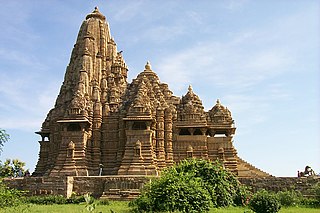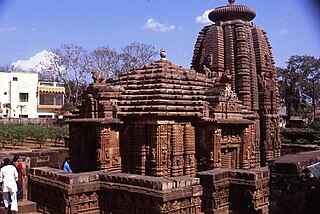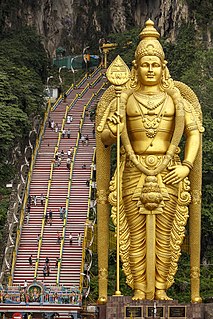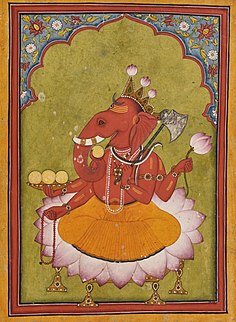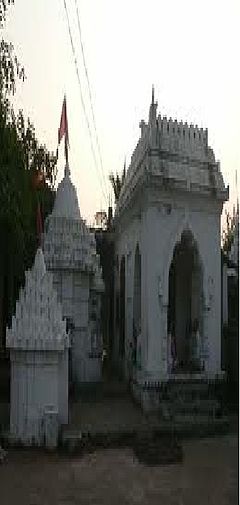
Jalesvara Siva Temple Precinct is a Hindu Temple dedicated to Lord Siva situated on the southern outskirt of the village Kalarahanga at a distance of 2.00 km from Patia and 6.00 km south of Chudangagada in the northern outskirt of Bhubaneswar. The presiding deity is a Siva-lingam within a circular yonipitha inside the sanctum, which is 1.15 meters below the chandrasila. The sanctum measures 2.00 square meters.
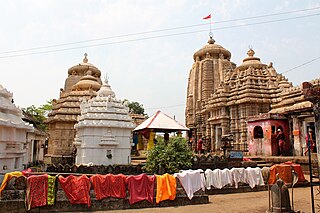
The Kapilesvara Siva temple is a Hindu temple dedicated to Lord Siva located in the south western outskirt of the village Kapilesvara, Old Town, Bhubaneswar, Orissa, India. It is located at the end of Kapilesvara road leading from Lingaraj temple to Kapilesvara Village. The presiding deity is a Siva-lingam at the center of a circular yonipitha inside the sanctum. It is a living temple, facing towards east and maintained by Kapilesvara Temple Trust Board. The temple is situated within the precinct along with 33 other monuments. The precinct is located on the northern embankment of Manikarnika tank over an area of 44.00 square metres.

Nilakanthesvara Shiva Temple is a temple in Orissa, India, located on the western embankment of the Bindusagar tank. It is situated on the left side of the lane branching from the road leading from Kedar Gouri chowk to the Vaitaḷa deuḷa in Bhubaneswar, the capital state of Orissa. The temple faces east. The temple's enshrining deity is a circular yoni pitha with a chlorite Siva lingam. The temple is made out of sandstone. The present temple is a recent construction over the remains of an earlier one. The building material is old but the entire structure now has cement plaster and an enamel point.

The Bhringesvara Siva temple is situated on the foothills of Dhauli and the left bank of the river Daya, in the southeastern outskirts of Bhubaneswar in the village Khatuapada. The temple is facing towards west and the presiding deity is a circular yoni pitha with a hole at the centre. The temple is made of light grey sandstone. The temple is renovated one from bottom to the top by employing the earlier materials. This temple is now under the protection of Orissa State Archaeology.

Purvesvara Siva Temple is located in Kancha Sahi, in the Old Town of Bhubaneswar. It was built in 13th century AD. It is a living temple and now under the care of Purvesvara Temple Development Association.

Belesvara Siva Temple is a 9th-century temple of Hindu god siva. This is one of the oldest temple in Bhubaneswar, a well known heritage place and capital of Orissa. It is of significance to Sivaratri, Sankranti, etc.

Markandesvara Siva Temple was constructed by Kesaris to commemorate the visit of sage Markandeya. Same as the Samesvara Siva temple. It is an abandoned temple and is facing towards the east. However at the center of the sanctum there is a Siva-lingam with the circular Yoni pitha. The temple is totally covered with wild vegetations.

Nilakantha Siva temple is located in the Kharakhia Baidyanatha temple precinct, Kharakhia Vaidyanath Sahi, Old Town, Bhubaneswar. One can approach to this site on the left side of the Vaidyanath road leading from Lingaraja temple to Kapilesvara. This is a living temple and is facing towards the west. The enshrining deity of this temple is a Siva lingam within a circular yoni pitha at the centre of the sanctum sanatorium. The sanctum is 0.77 metres below the chandrasila.

The Somesvara Siva temple is located in the Kharakhia Baidyanath temple precinct in Kharakhia Vaidyanath Sahi, Old Town, of Bhubaneswar. It is located approximately 300 metres south of Lingaraja temple. Visitors may approach the site on the left side of Baidyanath Road leading from Lingaraja temple to Kapilesvar. It is a living temple and faces towards the west. The enshrined deity of this temple is a Siva lingam within a circular yonipitha at the center of the sanctuary located 0.93 metres below the chandrasila. The temple is under the care and maintenance of Babulal Makaddam Badu Mohapatra, the chief priest of the temple, on whose private land the temple stands.

Gangesvara Siva Temple is situated within a precinct on the left side of the Ganges–Yamuna road Old Town, Bhubaneswar. It is located at a distance of 200 metres north-east of Lingaraj temple, 50 metres north of Lakhesvara temple across the road, 200 metres south of Subarnesvara and 100 metres east of Gourisankar temple. The temple is facing towards east. The presiding deity is a Siva lingam within a circular yonipitha. It is a living temple and maintained by the Ganga YamunaSangathana.
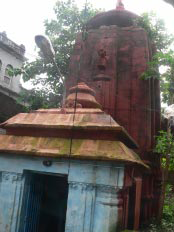
The Tirthesvara Siva temple is a Hindu template located in Bhubaneswar, the capital of Orissa, India.

Lakhesvara Siva temple Location: Lat 20° 14’ 33"N, Long 85° 50’ 17" E, Elev 60 ft. Approach- Lakhesvara Siva temple is located in the right side of the Ganges–Yamuna road, behind the Lingaraja market complex, Old town, Bhubaneswar. It is situated at a distance of 70 metres north east of Lingaraj temple and at a distance of 10 metres south of Gangesvara and Yamunesvara Siva temple across the road. The temple is facing towards the east. The enshrining deity is a Siva lingam within a circular yoni-pitha, which is 0.77 metres below the chandrasila.

Mangalesvara Siva Temple is a Hindu temple located in Bhubaneswar, Orissa, India. It is located at Lat- 20◦ 14’ 38" N., Long- 85◦ 50’ 38" E., and at an elevation of 45 ft.

Present Name- Lokanath Siva Temple Address: Tala Bazar Road, Old Town, Bhubaneswar.
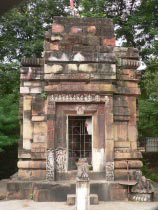
The Talesvara Siva temple is a Hindu temple in Bhubaneswar, Orissa, India.

Suka Temple is an abandoned and unused temple in Bhubaneswar, the capital of Odisha, India. The temple is devoted to saptaratha and the presence of female counterparts of the dikpalas in the upara jangha. This was built in the matured phase of temple building tradition of Odisha.

Sukutesvara Temple located in the old town of bhubaneswar serves as purpose for community gathering. The preceding deity in this temple is a Siva- lingam situated at the centre. The temple observes various religious sacraments like Mahasivaratri, Chandipatha and Rudrabhisekha.

Sinduresvara Siva temple is located in village Sundarpada, Old Town, Bhubaneswar. It is on the right side of the road leading from Lingaraj temple to Sundarpada. The enshrined deity is a circular yonipitha facing towards the north. The Siva lingam decayed in course of time. In April 2013 the villagers raised funds and reestablished new Shiv Linga. There are two entrances on the south-west and northwest corners provided with seven flights of steps leading down to the temple.

Manibhadresvara Siva temple is located in Bhubaneswar, Orissa, India.

Astasambhu Siva Temples is a collection of 8 Hindu temples dedicated to Lord Siva located in Bhubaneswar, the capital of Orissa, India.

